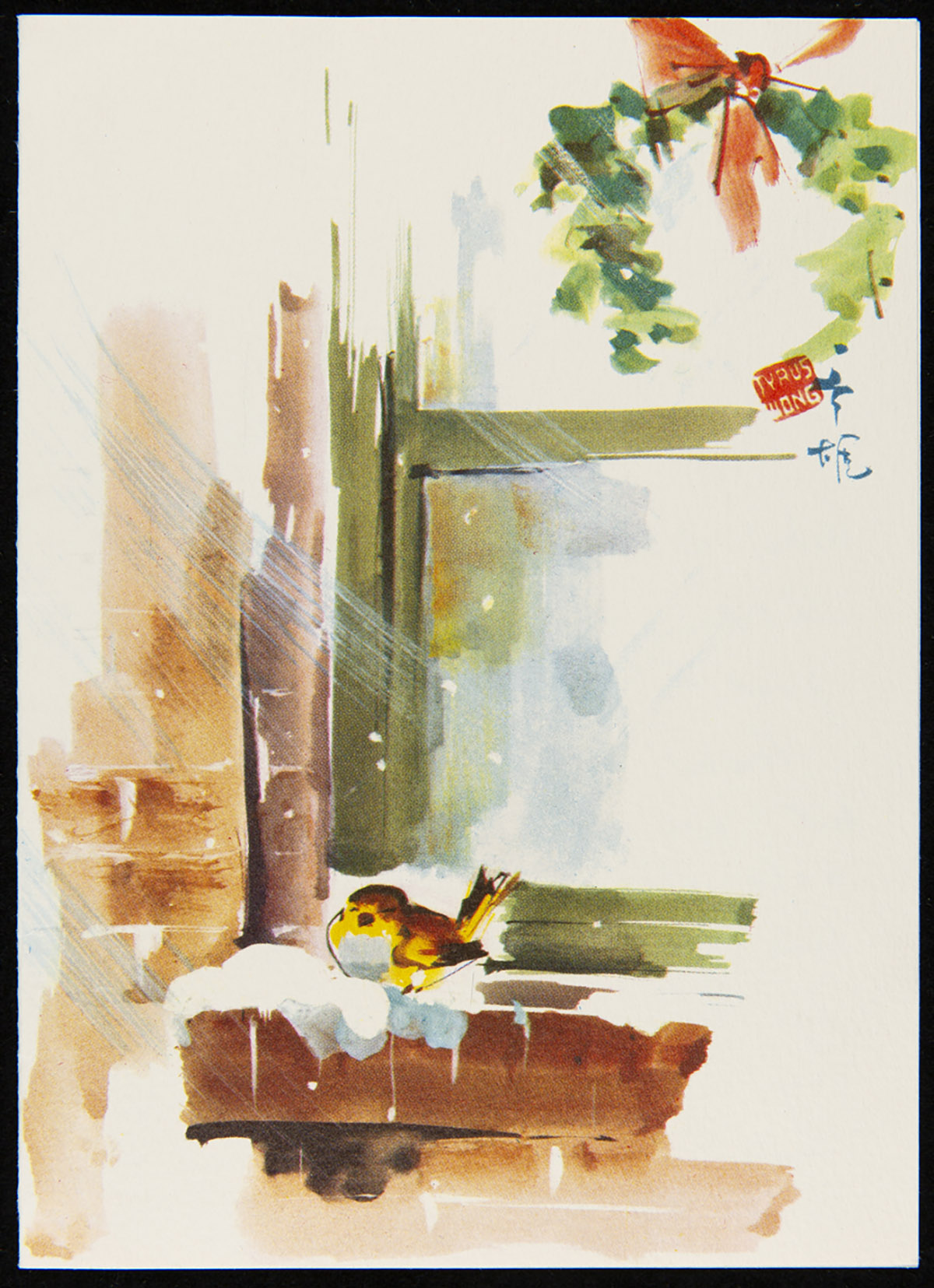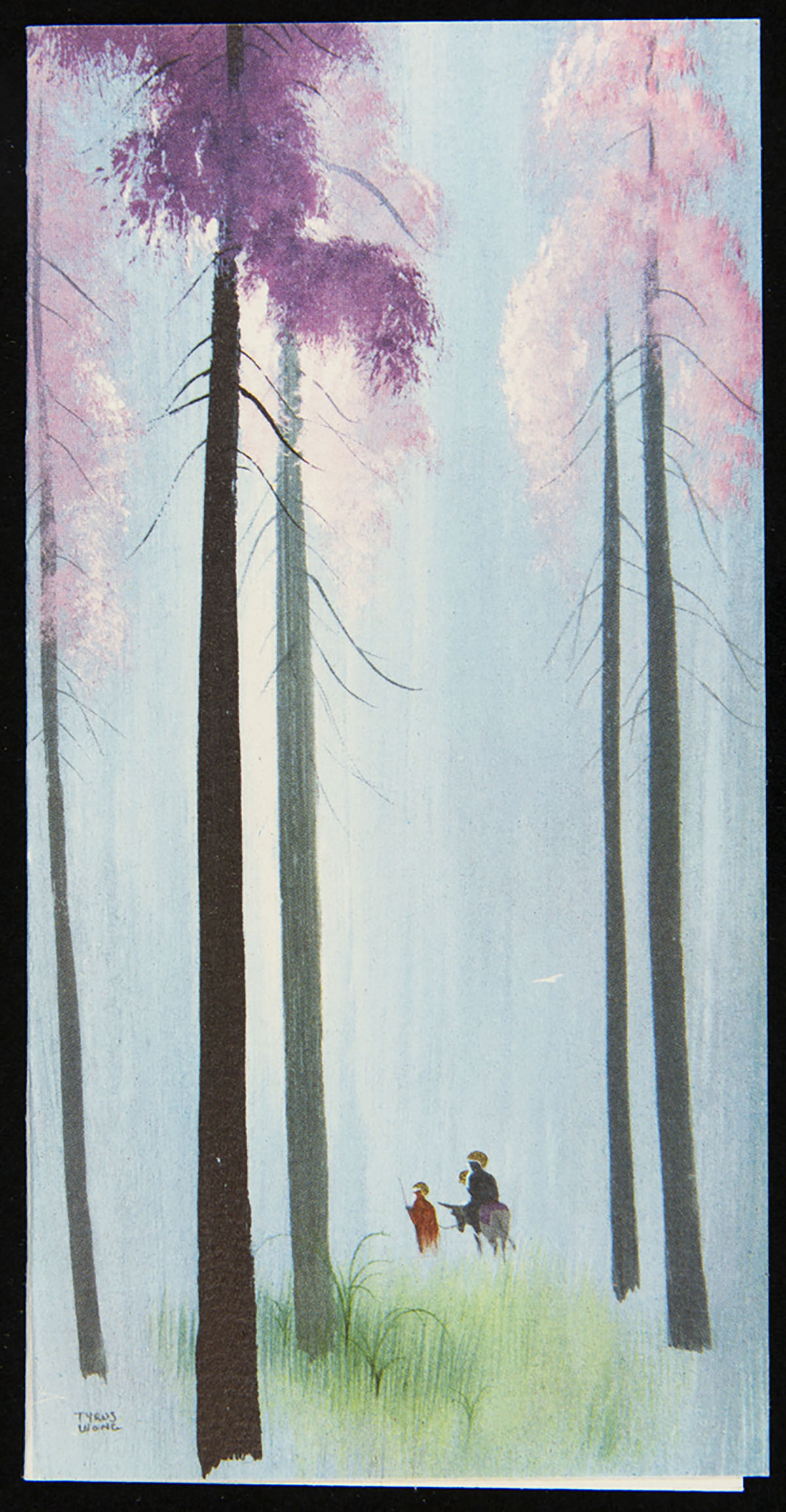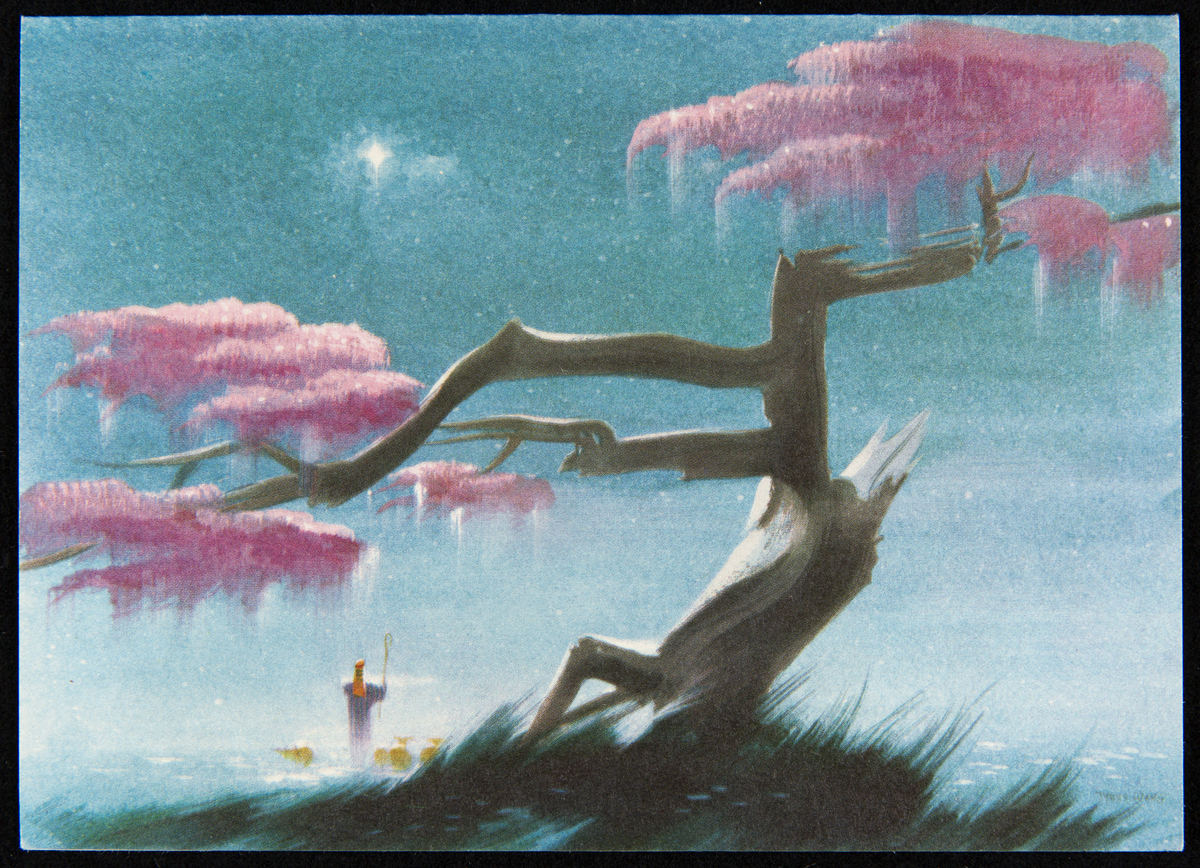Illustrating the Holidays: Christmas Cards by Tyrus Wong
Americans love to send — and receive — Christmas cards. Since the late 1800s, Christmas card production has grown, aided by inexpensive printing technologies and a prosperous — and increasingly mobile — American population. After the Second World War, greeting card companies looked for ways to outshine their competitors. Some companies commissioned production artists, animators, and illustrators who worked for West Coast film studios to create Christmas cards that appealed to mid-century Americans' tastes. Tyrus Wong, who worked for Disney and Warner Brothers Studios, is considered one of the finest Christmas card artists from the 1950s, '60s and '70s.

"Snow Bird," designed by Tyrus Wong for California Artists, 1955. / THF624835
Tyrus Wong
Tyrus Wong (1910-2016) and his father left China in 1920 and emigrated to the United States. Tyrus was only nine or 10 years old when he and his father arrived in San Francisco, California, passing through the Angel Island immigration station. (Angel Island was set up to enforce the Chinese Exclusion Act, a law restricting Chinese migrants and excluding them from citizenship.) There, they were separated — the father released, the young boy detained. Immigration officers interrogated the boy about his life and family in China — the U.S. government implemented this interrogation process to deter migration (officers hoped to find flaws in immigrants' stories as a reason to deport them back to China). Alone, scared and unable to speak English, Wong suffered for nearly a month before being released and finally reuniting with his father. Eventually, the two moved to the Los Angeles area.
Tyrus' father encouraged his son's love of art, teaching him to paint, draw and write calligraphy with a brush. His high school teacher, too, recognized Wong's ability and arranged a summer scholarship at Otis Art Institute in Los Angeles. Wong continued his studies at Otis, supplementing his lessons in Western art history by poring over books about classical Chinese painting. He became enamored with the art of the Song dynasty, admiring the idealized, atmospheric landscapes dotted with tiny figures. In the early 1930s, Wong graduated from Otis at the top of his class.
In Depression-era Southern California, Wong briefly worked for the Works Progress Administration — a government-funded program designed to employ millions of jobseekers, including out-of-work artists. He also painted murals and menus at the Dragon's Den, a restaurant in Los Angeles' Chinatown. During this time, Wong met and befriended other Asian artists, forming the Oriental Artist Group of Los Angeles and exhibiting works at local galleries and regional museums.
Most importantly, he met Ruth Kim, an American-born child of Chinese immigrants. Kim studied literature at UCLA and was a Sunday school teacher. The two worked for a time at the Dragon's Den. Tyrus married her in 1937, and she became a key collaborator in Wong's artistic journey, especially when he began designing Christmas cards — before he met Ruth, Tyrus had not celebrated Christmas.
In 1937, Wong went to work for Walt Disney Studios as an "inbetweener," sketching one animated frame after another in a production line. The work was tedious and unfulfilling. But then, Wong learned that Walt Disney planned to create an animated film based on the work of Felix Salten's novel Bambi, a Life in the Woods. Wong submitted some conceptual drawings showcasing the natural world in lush watercolors. Walt Disney loved them. Wong's artwork was unlike the busy, detailed backgrounds of Snow White. His atmospheric sketches — founded in traditional classical Chinese painting — captured the spirit of the forest. And they became the inspiration for the film's visual style.
Unfortunately, Wong went largely uncredited for years for what is now considered groundbreaking work. Wong left Walt Disney Studios in 1941 before the release of Bambi, and he became a production artist for Warner Brothers Studios, where he worked for more than 25 years.

"Enchanted Forest," designed by Tyrus Wong for California Artists, 1955. This card conveys the vastness of nature through its minuscule figures of Joseph and Mary traveling through a forest of tall pink and purple trees. / THF624838
Christmas Cards
After the Second World War, a colleague who had worked with Wong at Disney encouraged him to design Christmas cards. Creating artwork for Christmas cards became a way for many Hollywood studio artists like Wong to supplement their income.
Wong's Christmas card designs combined Eastern and Western art traditions. Many resembled traditional Chinese painting (gestural brushwork and a lack of linear perspective) applied to or with Western, often Christian, holiday imagery. The atmospheric landscapes in his cards' designs dwarf tiny figures, whether religious images (shepherds, Mary and Joseph, or Wise Men) or secular seasonal images (deer, birds, animals, persons or scenes). Other designs more closely evoke Eastern origins, such as bird-and-branch imagery that recalls Chinese scroll decoration or monochromatic images reminiscent of Sumi-e ink paintings. Still, others are reminiscent of movie settings, reflecting Wong's career as a Hollywood Studio artist. Wong's works blended his artistic and cultural backgrounds — his love of art (especially Asian art) and his life and education in America — creating a design mix that resonated with mid-20th-century Americans' growing interest in Asian aesthetics.

"The Shepherd," designed by Tyrus Wong for California Artists, 1954. Hot pink trees dwarf a shepherd and his flock. It was a bestseller, selling more than one million copies. / THF624841
And Wong was successful. In 1955, California Artists, a regional greeting card company, named Wong "Artist of the Year." In 1964, Hallmark honored Wong with a special promotional campaign — the only one the company provided for an individual artist that year. Three years later, another well-known greeting card company, Duncan McIntosh, dubbed Tyrus Wong "America's favorite Christmas card designer."
Wong would continue to produce Christmas cards into the 1970s.
Andy Stupperich is an associate curator at The Henry Ford.
To learn more about Tyrus Wong and his Christmas cards see:
Fang, Karen. “Commercial Design and Midcentury Asian American Art: The Greeting Cards of Tyrus Wong,” Panorama: Journal of the Association of Historians of American Art 7, no. 1 (spring 2021), https://doi.org/10.24926/24716839.11548.
Tom, Pamela. Tyrus. New Moon Pictures, 2015. Released as a PBS American Masters episode in 2017.

